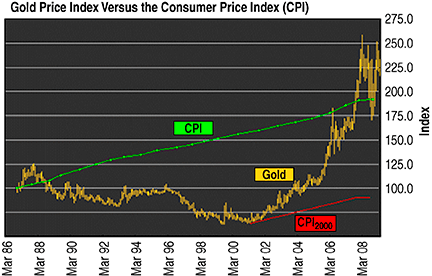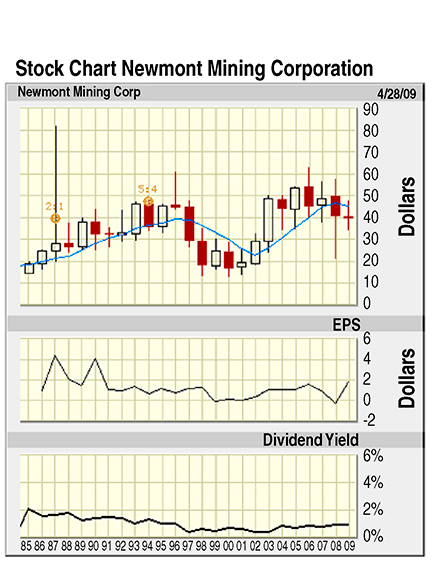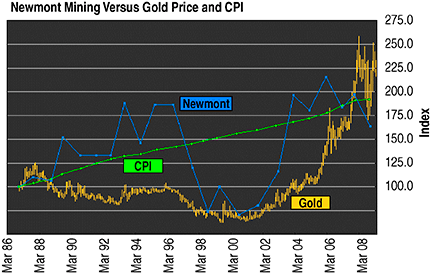
HOT TOPICS LIST
- Strategies
- Stocks
- Buy
- Investing
- Brokers
- Psychology
- Interviews
- Accumulate
- Sell
- Hold
- Spotlight
- Websites
- Candlestick Corner
- Gold & Metals
- Options Trading
LIST OF TOPICS
TRADER'S NOTEBOOK
To Invest (Or Not) In Gold
05/11/09 10:07:15 AM PSTby Thomas Maskell
Despite what some investors say, find yourself a real investment, because the yellow metal is not it. What’s that, you say? Gold isn’t a real investment?!
| You’ve heard the advertisements: “The only way to protect your assets is gold. It has never been worth nothing.” The truth is, as an investment, gold has always been worth nothing. To understand this, you must first understand the basic uses of money. There are only three things you can do with money: spend it, invest it, or hoard it. When you spend money, it is consumed. Food, shelter, clothing, and entertainment are all items that are consumed after purchase. When you invest money, you give it to a concept, an entrepreneur, or a business with the expectations that it will earn a return. The return may come in the form of dividends or interest, which are paid from current earnings, or capital gains, which are generated from retained earnings. When you hoard money, you get neither a return nor a consumable. There are two ways to hoard money: stick it into your mattress or convert it into a liquid asset. When you stick it in a mattress, you risk a loss of value to inflation. The value of money is determined by how much it can buy. As prices go up, the value of your mattress money goes down. Of course, prices can also go down (deflation). When deflation occurs, the value of your money rises. These are not returns; they are simply effects. One way to avoid the negative effects of inflation on your hoard of cash is to convert it to a liquid asset. For want of a better description, let’s call these assets collectables. Some good examples are art, precious metals, land, and Cabbage Patch dolls, if you’re old enough to remember those. The two key requirements of a collectable are that it be easily converted back into cash and that it does not deteriorate over time. Gold fits these two requirements; plus, it is universally accepted and widely traded. When people buy gold, they are actually just hoarding their money. Hoarding carries risks and opportunities. Money placed in the mattress will lose value if it inflates and gain value if it deflates. Money converted to gold will hold value if it inflates and hold value if it deflates. From a value standpoint, depending on the direction of the economy (inflation or deflation), the mattress is the better bet. Of course, if you know that inflation is going to continue, place your money in gold - maybe. SPECULATING WITH GOLD |
 FIGURE 1: GOLD VS. CPI. From 1986 to 2007, the CPI was on a steady upward climb. Except for a spike in 1987, gold went flat with a pronounced downward bias. It did not significantly rise above the 100-line until mid-2004. Figure 1 illustrates the relationship between the price of gold and the Consumer Price Index (CPI), which is a measure of inflation, from 1986 through 2008. At the end of 1986, both gold and the CPI are set at 100. From 1986 to 2007, the CPI was on a steady upward climb. Except for a spike in 1987, gold went flat with a pronounced downward bias. It did not significantly rise above the 100-line until mid-2004. Anyone buying gold in 1986 as a hedge against inflation would have been better off leaving their money in their mattress. |
| However, as the gap between the gold line and the CPI line grew, the character of the speculation changed. The CPI line can be viewed as a value line. The gold line is a price line. As the two diverged, gold ceased to be a tracking opportunity, and it became a value opportunity. Astute gold bugs could reasonably expect that gold would seek its true value. All it needed was a nudge, which apparently came when the stock market tumbled in 2000. TRADING IN GOLD INVESTING IN GOLD
Figure 3 illustrates how Newmont has outperformed gold and the CPI. Except for the Internet bubble (1997-2000), which drew money away from traditional investments, Newmont has consistently outperformed the CPI and the price of gold. Between 1997 and 2000, the downward pressure of gold prices and the money flows out of traditional stocks dragged Newmont’s share prices down. |
| However, that reversed once the bubble burst, and despite the proclamations by many experts that gold was passe, gold and Newmont both began a dramatic recovery. Was it predictable? History said yes; some experts said no; and the market agreed with the historians. FOOL’S GOLD Granted, the US government has decided to buy constant prosperity by printing money. This will cause more inflation, which might, if gold prices flatten, create another value opportunity. But now that the “experts” have abandoned their argument against gold, it will probably do a better job of tracking the CPI. If it does, it will return to its traditional role as a collectable. If it doesn’t track, buying gold now would be like buying it in 1986. It might provide psychological comfort, but it would be a financial mistake. As the CPI rises and gold stagnates, you lose value and money. The mattress is much more attractive. Or better yet, find yourself a real investment, because gold isn’t it.
SUGGESTED READING |
Thomas Maskell is a frequent S&C contributor whose recent book, The Complete Guide to Investing During Retirement, provides an excellent primer on investing, trading and speculation in the stock market. It is available nationwide. To comment on this article or his book, contact him at Retireestocks@aol.com or visit his blog at retireestocks.blogspot.com.
| E-mail address: | Retireestocks@aol.com |
PRINT THIS ARTICLE

|

Request Information From Our Sponsors
- StockCharts.com, Inc.
- Candle Patterns
- Candlestick Charting Explained
- Intermarket Technical Analysis
- John Murphy on Chart Analysis
- John Murphy's Chart Pattern Recognition
- John Murphy's Market Message
- MurphyExplainsMarketAnalysis-Intermarket Analysis
- MurphyExplainsMarketAnalysis-Visual Analysis
- StockCharts.com
- Technical Analysis of the Financial Markets
- The Visual Investor
- VectorVest, Inc.
- Executive Premier Workshop
- One-Day Options Course
- OptionsPro
- Retirement Income Workshop
- Sure-Fire Trading Systems (VectorVest, Inc.)
- Trading as a Business Workshop
- VectorVest 7 EOD
- VectorVest 7 RealTime/IntraDay
- VectorVest AutoTester
- VectorVest Educational Services
- VectorVest OnLine
- VectorVest Options Analyzer
- VectorVest ProGraphics v6.0
- VectorVest ProTrader 7
- VectorVest RealTime Derby Tool
- VectorVest Simulator
- VectorVest Variator
- VectorVest Watchdog


